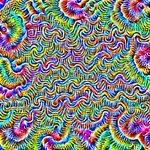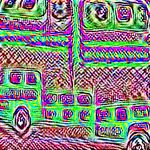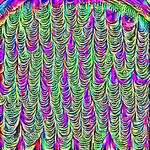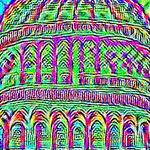UNIVERSAL ADVERSARIAL ROBUSTNESS OF TEXTURE AND SHAPE-BIASED MODELS
←
→
Page content transcription
If your browser does not render page correctly, please read the page content below
UNIVERSAL ADVERSARIAL ROBUSTNESS OF TEXTURE AND SHAPE-BIASED MODELS
Kenneth T. Co∗,† , Luis Muñoz-González∗ , Leslie Kanthan† , Ben Glocker∗ , Emil C. Lupu∗
∗
Department of Computing, Imperial College London, London, United Kingdom
†
DataSpartan Research, London, United Kingdom
{k.co, l.munoz, b.glocker, e.c.lupu}@imperial.ac.uk, l.kanthan@dataspartan.com
arXiv:1911.10364v4 [cs.CV] 31 Aug 2021
ABSTRACT DNNs have been shown to be extremely sensitive to adver-
Increasing shape-bias in deep neural networks has been sarial perturbations as they can be made to misclassify images
shown to improve robustness to common corruptions and with very high confidence. Adversarial attacks remain a rele-
noise. In this paper we analyze the adversarial robustness vant threat to shape-biased models as these attacks can greatly
of texture and shape-biased models to Universal Adversarial undermine the integrity and trust in model predictions.
Perturbations (UAPs). We use UAPs to evaluate the robust- Universal adversarial perturbations (UAP) are a particu-
ness of DNN models with varying degrees of shape-based larly potent class of adversarial attacks where a single UAP
training. We find that shape-biased models do not markedly can fool a model on a large set of input data [9]. From a ma-
improve adversarial robustness, and we show that ensembles chine learning perspective, UAPs reveal global features that
of texture and shape-biased models can improve universal ad- models are sensitive to [10, 11]. These global features are
versarial robustness while maintaining strong performance. worth studying as they can reveal underlying features that
models use for classification. From a security perspective,
Index Terms— Universal adversarial perturbations, ad- UAPs pose a worrying threat as they can transfer across mod-
versarial machine learning, deep neural networks els [12, 13], enable physically-realizable attacks on computer
vision systems [14, 15, 16], and can be used to facilitate ef-
1. INTRODUCTION ficient black-box attacks on DNNs [13]. Recent work shows
that there are some improvements in adversarial robustness to
Advances in computation and machine learning have enabled per-instance attacks by increasing shape-bias [17], however
Deep Neural Networks (DNNs) to become the algorithm of our results show that this is not the case for universal attacks.
choice for large-scale image classification [1, 2, 3]. To further In this work, we evaluate texture and shape-biased mod-
understand the types of features that computer vision DNNs els’ robustness to universal attacks, propose targeted UAPs
learn, [4, 5] we have investigated the effect of texture and as a method for visualizing and analyzing their most vulner-
shape-bias that models have on their performance. Evidence able features, and finally demonstrate that ensemble voting
from [4] and [5] demonstrate that it is sufficient for models to with these models can maintain clean performance whilst im-
use image textures to achieve high accuracy on ImageNet [6]. proving on worst-case performance against universal attacks.
Geirhos et al. propose Stylized-ImageNet, a modified Im- Our analysis with UAPs reveals the extent to which increased
ageNet dataset that requires recognizing object shapes rather shape-bias improves adversarial robustness of models to uni-
than textures to discriminate images in the dataset [5]. They versal attacks. The following are our contributions:
claim that biasing models towards shapes improves their ro-
bustness, and they show that these shape-biased models have 1. We show that shape-biased models do not mitigate uni-
improved robustness against common corruptions. However, versal attacks, but they instead shift the set of features
to have a complete characterization of a model’s robustness, the models are vulnerable to.
it is important to also study the worst-case distortions. These 2. We evaluate the distribution of targeted UAPs for tex-
worst-case distortions come in the form of adversarial pertur- ture and shape-biased models, and visualize the result-
bations: visually imperceptible changes to inputs that result ing targeted UAPs to show differences in the appear-
in images that fool the model [7, 8]. Despite their success, ance of resulting perturbations.
Kenneth Co is sponsored in part by DataSpartan research grant 3. Finally, we propose ensembles of texture and shape-
DSRD201801.
©2021 IEEE. Personal use of this material is permitted. Permission from
biased models to maintain strong performance and im-
IEEE must be obtained for all other uses, in any current or future media, prove robustness to universal attacks.
including reprinting/republishing this material for advertising or promotional
purposes, creating new collective works, for resale or redistribution to servers We make code available at https://github.com/
or lists, or reuse of any copyrighted component of this work in other works. kenny-co/sgd-uap-torch.ResNet50 (IN) ResNet50 (SIN+2IN) ResNet50 (SIN) ResNet50 (SIN+IN) VGG19 DenseNet121
Fig. 1. Untargeted UAPs generated for different models, from left to right: ResNet50 [3] models for various training regimes,
VGG19 [2], and DenseNet121 [18]. Complete details for how each ResNet50 model was trained are in Section 2.
2. BACKGROUND to have the best universal evasion rates over other methods
[20, 21], and it is a more efficient algorithm with better con-
In this section, we introduce shape-biased models and univer- vergence guarantees than the original UAP generation algo-
sal adversarial perturbations. The Stylized-ImageNet dataset rithm iterative-DeepFool [9].
was created to train models to have higher shape-bias. To
P
SGD optimizes the objective i L(xi + δ), where L is
study the robustness of these models with varying degrees of the model’s training loss, Xbatch = {xi } are batches of inputs,
shape-biased training, we first discuss how UAPs are gener- and δ ∈ P are the set of considered perturbations. Gradi-
ated and the metrics we use to measure their effectiveness. ent updates to δ are done in batches Xbatch in the direction
P
of − i ∇L(xi + δ). Pixel values of resulting adversarial
2.1. Shape-biased Training examples x + δ are clipped to the range [0, 255].
In this study, the perturbation constraints take the form
ImageNet is a widely used computer vision benchmark with of an `p -norm. The set of perturbations can be written as
1,000 distinct object categories [6]. Geirhos et al. created P(p, ε) = {δ | kδkp ≤ ε} for a chosen norm p and value ε.
a shape-biased dataset in Stylized-ImageNet, which replaces We choose p = ∞ as it is the standard in the UAP and adver-
textures of ImageNet images while retaining the global shape sarial machine learning literature. The `∞ -norm constraint on
of the original objects [5]. This dataset requires a model to use δ ensures that the perturbation is small and does not greatly
shapes rather than textures to identify and discriminate ob- alter the visual appearance of the resulting image.
jects. Stylized-ImageNet is generated by applying style trans- Fooling rate. We first consider the case where the goal
fer of different uninformative textures onto ImageNet images. of the UAP is to maximize the number of misclassifications.
The complete details of its generation are described in [5]. This is referred to as an untargeted UAP, as there is no specific
Models. We use the ResNet50 [3] architecture with vary- target output. Its effectiveness is measured by its fooling rate,
ing degrees of training on ImageNet and Stylized-ImageNet. which is the proportion of inputs that are misclassified by the
This model takes input images with dimensions 224×224×3. model when the UAP is applied. For targeted UAPs, the goal
We test UAPs on these four ResNet50 models, named accord- is to have as many inputs classified towards a desired target
ing to the training dataset used: only ImageNet (IN), only class ytarget . The targeted fooling rate (tFR) is the proportion
Stylized-ImageNet (SIN), both Stylized-ImageNet and Ima- of inputs classified as ytarget when the UAP is applied.
geNet (SIN+IN), and both Stylized-ImageNet and ImageNet,
and then fine-tuned on ImageNet for accuracy (SIN+2IN).
Complete training details for each model are given in [5]. 3. ROBUSTNESS OF SHAPE-BIASED MODELS
From here onwards, we use IN and SIN to refer to the models
rather than the datasets. In this section, we compare the robustness of ResNet50
models under different training regimes by measuring the ef-
fectiveness and transferability of untargeted UAPs generated
2.2. Universal Adversarial Perturbations
from the SGD attack. Our results show that models trained
Adversarial perturbations are universal when the same noise on Stylized-ImageNet are still as vulnerable to these UAPs as
pattern can be successfully applied across a large fraction of models trained on ImageNet.
the input data to fool a model [9]. Experimental setup. We consider the four ResNet50
Stochastic gradient descent. We use the Stochastic Gra- models as outlined in Sec. 2.1. We generate and optimize
dient Descent (SGD) algorithm for generating UAPs. SGD the SGD-based perturbations on each model for various `∞ -
is a variation of the Projected Gradient Descent (PGD) at- norms (2 ≤ ε ≤ 12) over the entire 50,000 image ImageNet
tack proposed in [19], but optimized over batches instead of validation set. The UAP literature often focuses on ε = 10,
individual images. SGD was chosen as it has been shown so we use this as our primary benchmark, but we also provide100 ResNet50 (IN) ResNet50 (SIN+2IN) ResNet50 (SIN+IN) ResNet50 (SIN)
90
Fooling Rate (%)
UAP Source
80 IN
70 SIN+2IN
60 SIN+IN
50 SIN
40 none
30
20
2 4 6 8 10 12 2 4 6 8 10 12 2 4 6 8 10 12 2 4 6 8 10 12
Fig. 2. Fooling rates (in %) of untargeted UAPs for different perturbation values ε. Plot titles indicate the evaluated model.
results for other values to measure its effectiveness under dif- able to depends more on the data distribution of its training
ferent perturbation constraints. For each UAP, we evaluate its dataset. It is interesting to note in Figure 2 that UAPs from IN
fooling rate on the model it was generated from (white-box and SIN+2IN have near-identical effectiveness against SIN.
attack) and on the three remaining models (transfer attack). Impact of fine-tuning. Although SIN+2IN achieves the
best clean dataset accuracy, our results show that its response
3.1. Transferability Across Training Regimes to UAPs is very similar to that of the model IN that was
trained only on ImageNet. In Figures 2 and 3, the fooling
White-box attacks, where the UAP is generated from the rates of UAPs from IN and SIN+2IN are highly similar across
tested model, achieve high success rates. They consistently all tested models. Additionally, there are large visual similari-
reach greater than 90% fooling rate for ε = 10 on all models ties between the UAPs generated for SIN+2IN and IN as seen
as shown in Figure 2. This shows that Stylized-ImageNet in Figure 1. These suggest that there are large similarities in
training does not necessarily improve the model robustness the features that SIN+2IN and IN are vulnerable to, despite
to universal attacks. For transfer attacks, where the UAP is the additional training on Stylized-ImageNet. The additional
generated from a model different from the evaluated one, the fine-tuning on ImageNet for SIN+2IN could have resulted in
fooling rate consistently rises for ε > 4. SIN appears to be the model “overfitting” where it no longer uses features it has
the most resilient to transfer attacks against all other models learned from both datasets, and instead focuses only on fea-
trained on the ImageNet dataset. However, this robustness to tures learned from ImageNet.
transfer attacks comes at the cost of having the highest clean
error on ImageNet.
3.2. Transferability Across Architectures
IN 92.5 81.9 63.3 48.3 68.2 59.3 We now consider the transferability of the UAPs from these
SIN+2IN 85.4 88.2 66.3 49.3 65.7 54.5 ResNet50 models to other architectures: DenseNet121 [18]
and VGG19 [2]. Like ResNet50, these models take input
UAP Source
SIN+IN 86.9 85.5 91.7 70.0 78.9 70.5 images of dimension 224 × 224 × 3 and have comparable
SIN 56.5 57.2 69.9 92.4 60.2 50.5 clean dataset accuracies. Compared to ResNet50, VGG19 has
fewer layers, whilst the DenseNet121 has more layers and
V19 50.1 46.8 38.7 44.6 93.9 44.4
uses dense blocks. The architectures have approximately 8,
D121 66.0 60.6 51.1 49.9 71.0 88.5 25, and 140 million parameters for DenseNet121, ResNet50,
IN SIN+2IN SIN+IN SIN V19 D121 and VGG19 respectively. We focus our analysis on attacks
Tested Model with ε = 10.
In Figure 3, VGG19 is noticeably more vulnerable to all
Fig. 3. Confusion matrix showing the fooling rates (in %) of UAPs, whereas DenseNet121 is more resilient to the UAPs
untargeted UAPs with ε = 10 when applied as transfer attacks from the other models. When focusing only on the ImageNet-
to different models. VGG19 and DenseNet121 are labeled as trained models (IN, VGG19, DenseNet121), we see that the
V19 and D121 respectively. architectures with more layers and fewer parameters appear to
be more robust. Compared to IN, SIN does not improve on the
That white-box UAPs are still effective against SIN shows transferability of UAPs to these other architectures. However,
that Stylized-ImageNet training does not diminish the effects the UAP from SIN+IN has noticeably higher transferability
of UAPs. Instead, Stylized-ImageNet training shifts the set of against all models, achieving at least 70% fooling rate against
features the model has learned, making it vulnerable to a dif- each model. We hypothesize that SIN+IN has learned more
ferent set of features from what the ImageNet-trained models generalized representations because it was trained equally on
have learned. Hence, what features models are most vulner- both ImageNet and Stylized-ImageNet without overfitting toTarget Class: 734 (police van, police wagon, wagon) would make sense as UAPs across the three models (IN, SIN,
ResNet50 (IN) ResNet50 (SIN) ResNet50 (SIN+IN) SIN+IN) do not transfer perfectly and their targeted UAPs ev-
idence some diversity in visual appearance and effectiveness.
Experimental setup. To combine IN, SIN, and SIN+IN,
we consider two ensemble voting schemes: a hard voting
scheme where the ensemble outputs the majority class la-
bel, and a soft voting scheme where the ensemble outputs the
class label with the highest average probability after the soft-
tFR: 54.59% tFR: 68.05% tFR: 41.09% max layer. For both voting schemes, the ensemble outputs no
prediction if there is no majority. To compare the ensemble
Fig. 4. An example of a targeted UAP and with its tFR for scheme with the original models, we measure their accuracy
each model it was generated for. on the clean dataset and the lowest accuracy achieved on any
of the UAPs generated so far at ε = 10. This is to consider
160 the worst-case robustness of these models to universal attacks.
# of Targeted UAPs
IN For IN, SIN, and SIN+IN, this would be their accuracy against
120 SIN
SIN+IN their corresponding white-box untargeted UAP.
80
40
Table 1. Accuracy (in %) of ResNet50 models and ensembles
0
30 40 50 60 70 80 for the clean ImageNet validation set and on the worst-case
Targeted Fooling Rate (%) UAP at = 10. Highest model accuracy is highlighted.
Fig. 5. Distribution of tFR of targeted UAPs on the ResNet50 Model Clean Worst-case UAP
models, with one UAP for each ImageNet class labels. IN 76.13 7.50
SIN 60.18 7.65
SIN+IN 74.59 8.33
either, thus allowing it to have a more potent transfer attack Ensemble (hard) 73.24 17.25
to the other model architectures. Ensemble (soft) 76.02 20.37
3.3. Effectiveness of Targeted Universal Attacks Results. In Table 1, both ensembles improve on the ro-
We now show how targeted UAPs can be used to visualize bustness to the worst universal attack when compared to the
and analyze the sensitivity of the ResNet50 models to UAPs individual models, with soft voting achieving the highest ac-
for each class label. We omit the analysis for SIN+2IN as its curacy of 20.37%, more than 10 points better than the indi-
robustness to universal attacks is highly similar to that of IN. vidual models. The soft ensemble also achieves a clean ac-
Targeted UAPs are generated for each of the 1,000 Im- curacy of 76.02%, which is very close to the highest clean
ageNet class labels with ε = 10 on each of the ResNet50 accuracy of IN at 76.13%. This demonstrates that the en-
models and their effectiveness is measured by their targeted semble with soft voting is able to maintain clean accuracy
fooling rate (tFR). Figure 4 shows an example of how the dif- while greatly improving adversarial robustness to universal
ferent training regimes result in targeted UAPs with differing attacks. Although the adversarial robustness of the ensem-
visual appearances despite targeting the same class. ble could still be improved, this is a promising direction and
Figure 5 shows that the tFR ranges from approximately demonstrates that ensemble methods can improve adversarial
30-80% and the majority of the 1,000 targeted UAPs for each robustness work while maintaining clean accuracy.
model are centered the around 50-70% tFR range. What
stands out is that SIN+IN appears to be slightly more robust 5. CONCLUSION
to targeted UAPs as its tFR distribution is shifted to the left
when compared to IN and SIN. Since SIN+IN blends ele- We study texture and shape-biased models through the lens of
ments from both datasets, its larger and more diverse training universal adversarial robustness and show that shape-biased
may have made it more robust to targeted UAPs. models are as vulnerable to universal attacks as texture-biased
models. We demonstrate how UAPs can be used to better
4. MITIGATING ATTACKS WITH ENSEMBLES evaluate the robustness of models with differing degrees of
texture and shape-biased training. Finally, we propose en-
Based on results from the previous section, we test an en- sembles of texture and shape-bias models and show that it
semble voting mechanism to improve the overall robustness can maintain clean performance while improving on univer-
to universal attacks and maintain clean performance. This sal adversarial robustness.6. REFERENCES [11] Kenneth T. Co, David Martinez Rego, and Emil C.
Lupu, “Jacobian regularization for mitigating uni-
[1] Alex Krizhevsky, Ilya Sutskever, and Geoffrey E. Hin- versal adversarial perturbations,” arXiv preprint
ton, “Imagenet classification with deep convolutional arXiv:2104.10459, 2021.
neural networks,” in Advances in Neural Information
Processing Systems, 2012, pp. 1097–1105. [12] Florian Tramèr and Dan Boneh, “Adversarial training
and robustness for multiple perturbations,” in Advances
[2] Karen Simonyan and Andrew Zisserman, “Very deep in Neural Information Processing Systems, 2019, pp.
convolutional networks for large-scale image recogni- 5858–5868.
tion,” arXiv preprint arXiv:1409.1556, 2014.
[13] Kenneth T. Co, Luis Muñoz González, Sixte de Mau-
[3] Kaiming He, Xiangyu Zhang, Shaoqing Ren, and Jian peou, and Emil C. Lupu, “Procedural noise adversarial
Sun, “Deep residual learning for image recognition,” in examples for black-box attacks on deep convolutional
Proceedings of the IEEE Conference on Computer Vi- networks,” in ACM Conference on Computer and Com-
sion and Pattern Recognition, 2016, pp. 770–778. munications Security, 2019, CCS ’19, pp. 275–289.
[4] Wieland Brendel and Matthias Bethge, “Approximating [14] Anish Athalye, Logan Engstrom, Andrew Ilyas, and
cnns with bag-of-local-features models works surpris- Kevin Kwok, “Synthesizing robust adversarial exam-
ingly well on imagenet,” in Intl. Conference on Learn- ples,” in Intl. Conference on Machine Learning. PMLR,
ing Representations, 2019. 2018, pp. 284–293.
[5] Robert Geirhos, Patricia Rubisch, Claudio Michaelis, [15] Kevin Eykholt, Ivan Evtimov, Earlence Fernandes,
Matthias Bethge, Felix A. Wichmann, and Wieland Bo Li, Amir Rahmati, Chaowei Xiao, Atul Prakash,
Brendel, “Imagenet-trained cnns are biased towards tex- Tadayoshi Kohno, and Dawn Song, “Robust physical-
ture; increasing shape bias improves accuracy and ro- world attacks on deep learning visual classification,” in
bustness,” in Intl. Conference on Learning Representa- Proceedings of the IEEE Conference on Computer Vi-
tions, 2019. sion and Pattern Recognition, 2018, pp. 1625–1634.
[16] James Tu, Mengye Ren, Sivabalan Manivasagam, Ming
[6] Olga Russakovsky, Jia Deng, Hao Su, Jonathan Krause,
Liang, Bin Yang, Richard Du, Frank Cheng, and Raquel
Sanjeev Satheesh, Sean Ma, Zhiheng Huang, Andrej
Urtasun, “Physically realizable adversarial examples for
Karpathy, Aditya Khosla, Michael Bernstein, et al.,
lidar object detection,” in Proceedings of the IEEE Con-
“Imagenet large scale visual recognition challenge,”
ference on Computer Vision and Pattern Recognition,
Intl. Journal of Computer Vision, vol. 115, no. 3, pp.
2020, pp. 13716–13725.
211–252, 2015.
[17] Baifeng Shi, Dinghuai Zhang, Qi Dai, Zhanxing Zhu,
[7] Battista Biggio, Igino Corona, Davide Maiorca, Blaine
Yadong Mu, and Jingdong Wang, “Informative dropout
Nelson, Nedim Šrndić, Pavel Laskov, Giorgio Giac-
for robust representation learning: A shape-bias per-
into, and Fabio Roli, “Evasion attacks against machine
spective,” in Intl. Conference on Machine Learning.
learning at test time,” in European Conference on Ma-
PMLR, 2020, pp. 8828–8839.
chine Learning and Knowledge Discovery in Databases.
Springer, 2013, pp. 387–402. [18] Gao Huang, Zhuang Liu, Laurens Van Der Maaten, and
Kilian Q Weinberger, “Densely connected convolutional
[8] Christian Szegedy, Wojciech Zaremba, Ilya Sutskever, networks,” in Computer Vision and Pattern Recognition,
Dumitru Erhan, Joan Bruna, Ian Goodfellow, and Rob 2017, pp. 4700–4708.
Fergus, “Intriguing properties of neural networks,” in
Intl. Conference on Learning Representations, 2014. [19] Aleksander Madry, Aleksandar Makelov, Ludwig
Schmidt, Dimitris Tsipras, and Adrian Vladu, “Towards
[9] Seyed-Mohsen Moosavi-Dezfooli, Alhussein Fawzi, deep learning models resistant to adversarial attacks,” in
Omar Fawzi, and Pascal Frossard, “Universal adver- Intl. Conference on Learning Representations, 2018.
sarial perturbations,” in Proceedings of the IEEE Con-
ference on Computer Vision and Pattern Recognition, [20] Ali Shafahi, Mahyar Najibi, Zheng Xu, John Dickerson,
2017, pp. 1765–1773. Larry S. Davis, and Tom Goldstein, “Universal adver-
sarial training,” arXiv preprint arXiv:1811.11304, 2018.
[10] Andrew Ilyas, Shibani Santurkar, Dimitris Tsipras, Lo-
[21] Yingpeng Deng and Lina J Karam, “Universal adver-
gan Engstrom, Brandon Tran, and Aleksander Madry,
sarial attack via enhanced projected gradient descent,”
“Adversarial examples are not bugs, they are features,”
in IEEE Intl. Conference on Image Processing. IEEE,
in Advances in Neural Information Processing Systems,
2020, pp. 1241–1245.
2019.You can also read


























































